Immigrants from Canada vs White/Caucasian Community Comparison
COMPARE
Immigrants from Canada
White/Caucasian
Social Comparison
Social Comparison
Immigrants from Canada
Whites/Caucasians
8,413
SOCIAL INDEX
81.6/ 100
SOCIAL RATING
73rd/ 347
SOCIAL RANK
5,140
SOCIAL INDEX
48.9/ 100
SOCIAL RATING
185th/ 347
SOCIAL RANK
White/Caucasian Integration in Immigrants from Canada Communities
The statistical analysis conducted on geographies consisting of 459,401,927 people shows a substantial positive correlation between the proportion of Whites/Caucasians within Immigrant from Canada communities in the United States with a correlation coefficient (R) of 0.518. On average, for every 1% (one percent) increase in Immigrants from Canada within a typical geography, there is an increase of 0.310% in Whites/Caucasians. To illustrate, in a geography comprising of 100,000 individuals, a rise of 1,000 Immigrants from Canada corresponds to an increase of 310.5 Whites/Caucasians.
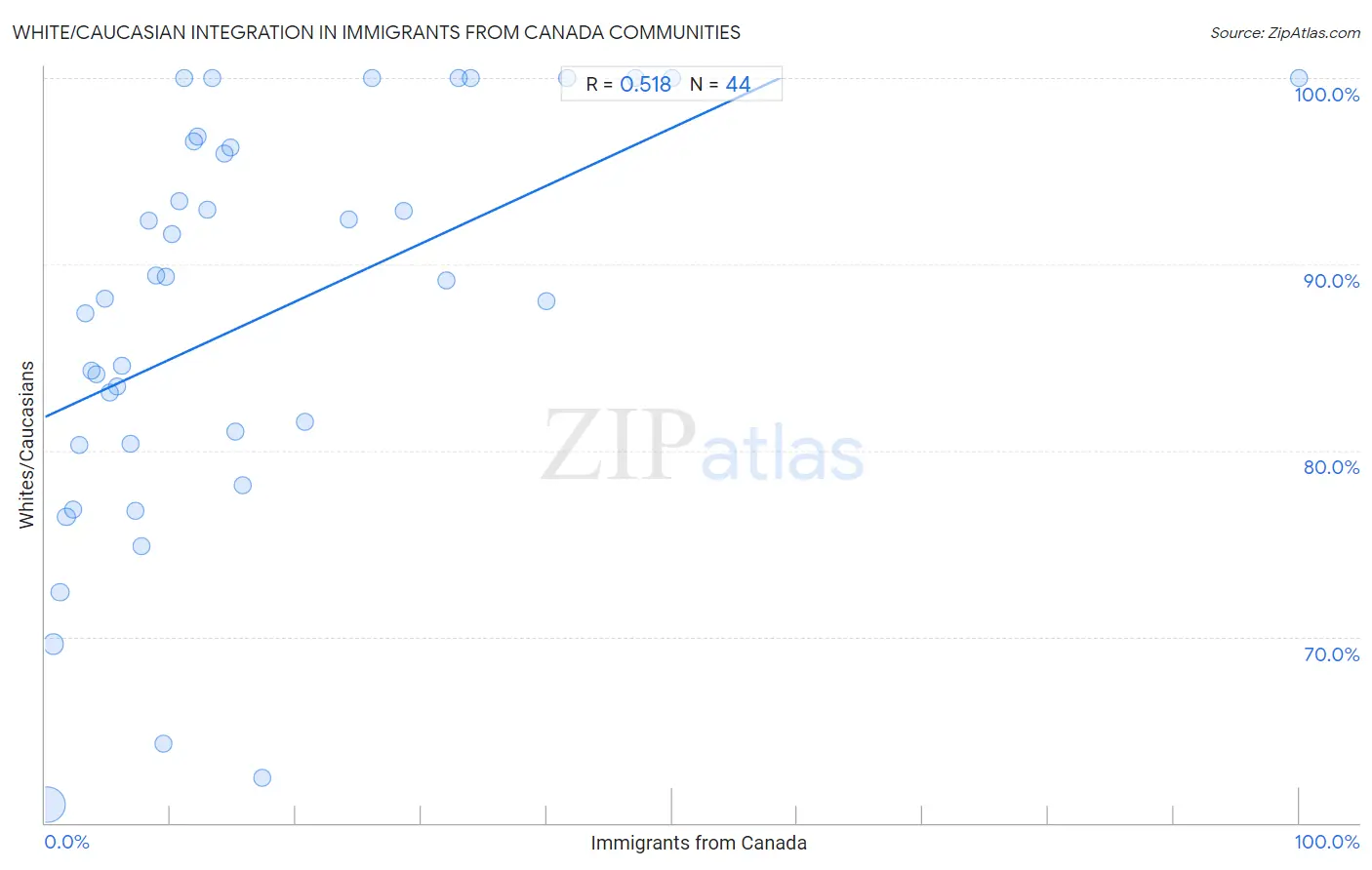
Immigrants from Canada vs White/Caucasian Income
When considering income, the most significant differences between Immigrants from Canada and White/Caucasian communities in the United States are seen in per capita income ($49,412 compared to $42,180, a difference of 17.2%), median family income ($112,374 compared to $99,800, a difference of 12.6%), and median household income ($92,029 compared to $82,029, a difference of 12.2%). Conversely, both communities are more comparable in terms of wage/income gap (28.5% compared to 28.5%, a difference of 0.18%), householder income under 25 years ($53,411 compared to $50,336, a difference of 6.1%), and median female earnings ($41,373 compared to $37,531, a difference of 10.2%).

| Income Metric | Immigrants from Canada | White/Caucasian |
| Per Capita Income | Exceptional $49,412 | Poor $42,180 |
| Median Family Income | Exceptional $112,374 | Poor $99,800 |
| Median Household Income | Exceptional $92,029 | Poor $82,029 |
| Median Earnings | Exceptional $50,192 | Poor $45,197 |
| Median Male Earnings | Exceptional $60,388 | Fair $53,925 |
| Median Female Earnings | Exceptional $41,373 | Tragic $37,531 |
| Householder Age | Under 25 years | Exceptional $53,411 | Tragic $50,336 |
| Householder Age | 25 - 44 years | Exceptional $102,616 | Poor $91,668 |
| Householder Age | 45 - 64 years | Exceptional $109,402 | Fair $98,091 |
| Householder Age | Over 65 years | Exceptional $64,952 | Tragic $58,847 |
| Wage/Income Gap | Tragic 28.5% | Tragic 28.5% |
Immigrants from Canada vs White/Caucasian Poverty
When considering poverty, the most significant differences between Immigrants from Canada and White/Caucasian communities in the United States are seen in child poverty under the age of 5 (15.8% compared to 18.1%, a difference of 14.4%), female poverty among 25-34 year olds (12.9% compared to 14.7%, a difference of 14.0%), and receiving food stamps (9.7% compared to 11.1%, a difference of 13.8%). Conversely, both communities are more comparable in terms of seniors poverty over the age of 75 (11.2% compared to 11.4%, a difference of 1.8%), seniors poverty over the age of 65 (9.8% compared to 10.0%, a difference of 2.3%), and female poverty among 18-24 year olds (19.5% compared to 20.8%, a difference of 6.7%).
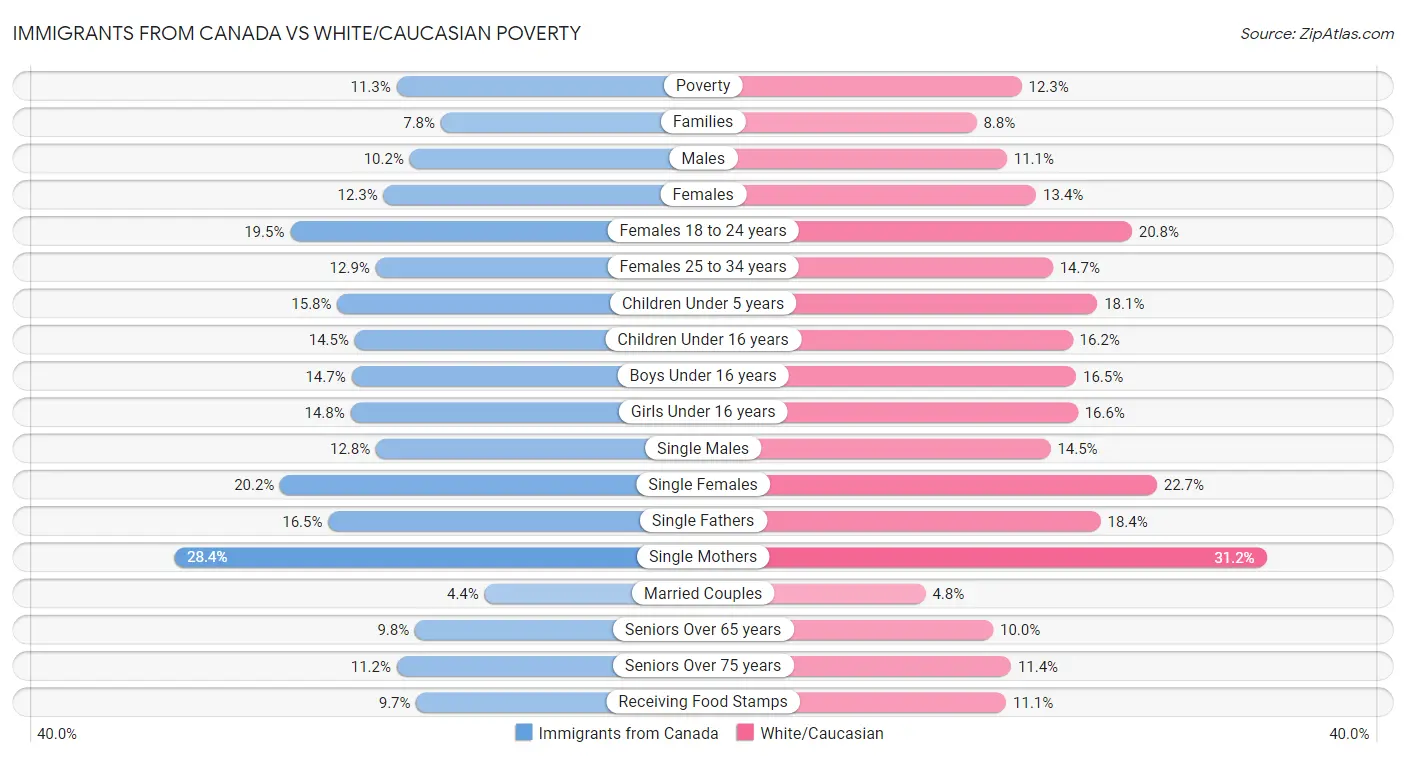
| Poverty Metric | Immigrants from Canada | White/Caucasian |
| Poverty | Exceptional 11.3% | Average 12.3% |
| Families | Exceptional 7.8% | Good 8.8% |
| Males | Exceptional 10.2% | Average 11.1% |
| Females | Exceptional 12.3% | Average 13.4% |
| Females 18 to 24 years | Exceptional 19.5% | Tragic 20.8% |
| Females 25 to 34 years | Exceptional 12.9% | Tragic 14.7% |
| Children Under 5 years | Exceptional 15.8% | Poor 18.1% |
| Children Under 16 years | Exceptional 14.5% | Average 16.2% |
| Boys Under 16 years | Exceptional 14.7% | Average 16.5% |
| Girls Under 16 years | Exceptional 14.8% | Average 16.6% |
| Single Males | Average 12.8% | Tragic 14.5% |
| Single Females | Exceptional 20.2% | Tragic 22.7% |
| Single Fathers | Fair 16.5% | Tragic 18.4% |
| Single Mothers | Excellent 28.4% | Tragic 31.2% |
| Married Couples | Exceptional 4.4% | Exceptional 4.8% |
| Seniors Over 65 years | Exceptional 9.8% | Exceptional 10.0% |
| Seniors Over 75 years | Exceptional 11.2% | Exceptional 11.4% |
| Receiving Food Stamps | Exceptional 9.7% | Excellent 11.1% |
Immigrants from Canada vs White/Caucasian Unemployment
When considering unemployment, the most significant differences between Immigrants from Canada and White/Caucasian communities in the United States are seen in unemployment among women with children under 6 years (7.6% compared to 8.4%, a difference of 10.3%), unemployment among seniors over 75 years (9.2% compared to 10.1%, a difference of 9.8%), and unemployment among ages 30 to 34 years (5.4% compared to 5.7%, a difference of 6.0%). Conversely, both communities are more comparable in terms of unemployment among ages 60 to 64 years (4.7% compared to 4.7%, a difference of 0.010%), unemployment among youth under 25 years (11.2% compared to 11.2%, a difference of 0.070%), and unemployment among ages 20 to 24 years (10.1% compared to 10.1%, a difference of 0.070%).
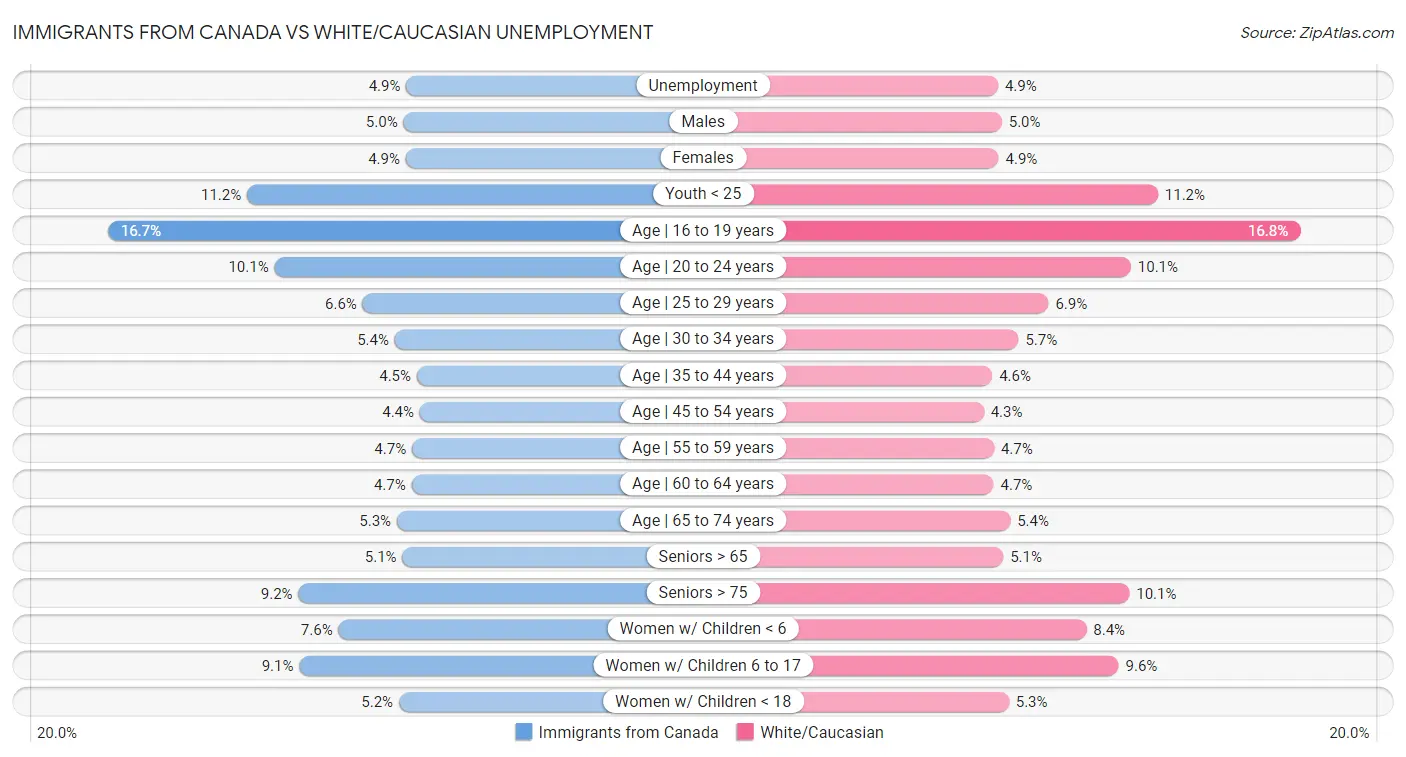
| Unemployment Metric | Immigrants from Canada | White/Caucasian |
| Unemployment | Exceptional 4.9% | Exceptional 4.9% |
| Males | Exceptional 5.0% | Exceptional 5.0% |
| Females | Exceptional 4.9% | Exceptional 4.9% |
| Youth < 25 | Exceptional 11.2% | Exceptional 11.2% |
| Age | 16 to 19 years | Exceptional 16.7% | Exceptional 16.8% |
| Age | 20 to 24 years | Excellent 10.1% | Excellent 10.1% |
| Age | 25 to 29 years | Average 6.6% | Poor 6.9% |
| Age | 30 to 34 years | Good 5.4% | Tragic 5.7% |
| Age | 35 to 44 years | Exceptional 4.5% | Good 4.6% |
| Age | 45 to 54 years | Exceptional 4.4% | Exceptional 4.3% |
| Age | 55 to 59 years | Exceptional 4.7% | Exceptional 4.7% |
| Age | 60 to 64 years | Exceptional 4.7% | Exceptional 4.7% |
| Age | 65 to 74 years | Excellent 5.3% | Average 5.4% |
| Seniors > 65 | Excellent 5.1% | Excellent 5.1% |
| Seniors > 75 | Tragic 9.2% | Tragic 10.1% |
| Women w/ Children < 6 | Good 7.6% | Tragic 8.4% |
| Women w/ Children 6 to 17 | Poor 9.1% | Tragic 9.6% |
| Women w/ Children < 18 | Exceptional 5.2% | Excellent 5.3% |
Immigrants from Canada vs White/Caucasian Labor Participation
When considering labor participation, the most significant differences between Immigrants from Canada and White/Caucasian communities in the United States are seen in in labor force | age 16-19 (38.9% compared to 41.3%, a difference of 6.1%), in labor force | age 20-24 (75.9% compared to 76.9%, a difference of 1.3%), and in labor force | age 30-34 (84.6% compared to 83.9%, a difference of 0.84%). Conversely, both communities are more comparable in terms of in labor force | age > 16 (63.7% compared to 63.6%, a difference of 0.16%), in labor force | age 20-64 (79.0% compared to 78.5%, a difference of 0.63%), and in labor force | age 35-44 (84.2% compared to 83.6%, a difference of 0.64%).

| Labor Participation Metric | Immigrants from Canada | White/Caucasian |
| In Labor Force | Age > 16 | Tragic 63.7% | Tragic 63.6% |
| In Labor Force | Age 20-64 | Tragic 79.0% | Tragic 78.5% |
| In Labor Force | Age 16-19 | Exceptional 38.9% | Exceptional 41.3% |
| In Labor Force | Age 20-24 | Exceptional 75.9% | Exceptional 76.9% |
| In Labor Force | Age 25-29 | Good 84.8% | Tragic 84.2% |
| In Labor Force | Age 30-34 | Fair 84.6% | Tragic 83.9% |
| In Labor Force | Age 35-44 | Poor 84.2% | Tragic 83.6% |
| In Labor Force | Age 45-54 | Fair 82.5% | Tragic 81.9% |
Immigrants from Canada vs White/Caucasian Family Structure
When considering family structure, the most significant differences between Immigrants from Canada and White/Caucasian communities in the United States are seen in single father households (2.2% compared to 2.4%, a difference of 10.4%), single mother households (5.6% compared to 6.1%, a difference of 9.3%), and births to unmarried women (30.4% compared to 33.3%, a difference of 9.2%). Conversely, both communities are more comparable in terms of married-couple households (48.4% compared to 48.6%, a difference of 0.33%), currently married (48.8% compared to 48.6%, a difference of 0.37%), and average family size (3.12 compared to 3.14, a difference of 0.93%).

| Family Structure Metric | Immigrants from Canada | White/Caucasian |
| Family Households | Poor 64.0% | Exceptional 65.1% |
| Family Households with Children | Tragic 26.5% | Average 27.4% |
| Married-couple Households | Exceptional 48.4% | Exceptional 48.6% |
| Average Family Size | Tragic 3.12 | Tragic 3.14 |
| Single Father Households | Exceptional 2.2% | Fair 2.4% |
| Single Mother Households | Exceptional 5.6% | Good 6.1% |
| Currently Married | Exceptional 48.8% | Exceptional 48.6% |
| Divorced or Separated | Average 12.1% | Tragic 12.6% |
| Births to Unmarried Women | Excellent 30.4% | Poor 33.3% |
Immigrants from Canada vs White/Caucasian Vehicle Availability
When considering vehicle availability, the most significant differences between Immigrants from Canada and White/Caucasian communities in the United States are seen in no vehicles in household (8.7% compared to 7.0%, a difference of 24.1%), 4 or more vehicles in household (6.5% compared to 7.4%, a difference of 12.7%), and 3 or more vehicles in household (20.2% compared to 22.6%, a difference of 11.6%). Conversely, both communities are more comparable in terms of 1 or more vehicles in household (91.4% compared to 93.1%, a difference of 1.9%), 2 or more vehicles in household (57.5% compared to 60.8%, a difference of 5.7%), and 3 or more vehicles in household (20.2% compared to 22.6%, a difference of 11.6%).

| Vehicle Availability Metric | Immigrants from Canada | White/Caucasian |
| No Vehicles Available | Exceptional 8.7% | Exceptional 7.0% |
| 1+ Vehicles Available | Exceptional 91.4% | Exceptional 93.1% |
| 2+ Vehicles Available | Exceptional 57.5% | Exceptional 60.8% |
| 3+ Vehicles Available | Excellent 20.2% | Exceptional 22.6% |
| 4+ Vehicles Available | Good 6.5% | Exceptional 7.4% |
Immigrants from Canada vs White/Caucasian Education Level
When considering education level, the most significant differences between Immigrants from Canada and White/Caucasian communities in the United States are seen in professional degree (5.3% compared to 4.1%, a difference of 31.2%), doctorate degree (2.3% compared to 1.8%, a difference of 28.4%), and master's degree (17.2% compared to 13.8%, a difference of 24.5%). Conversely, both communities are more comparable in terms of 7th grade (96.9% compared to 97.0%, a difference of 0.010%), 4th grade (98.1% compared to 98.1%, a difference of 0.020%), and 5th grade (97.9% compared to 97.9%, a difference of 0.020%).
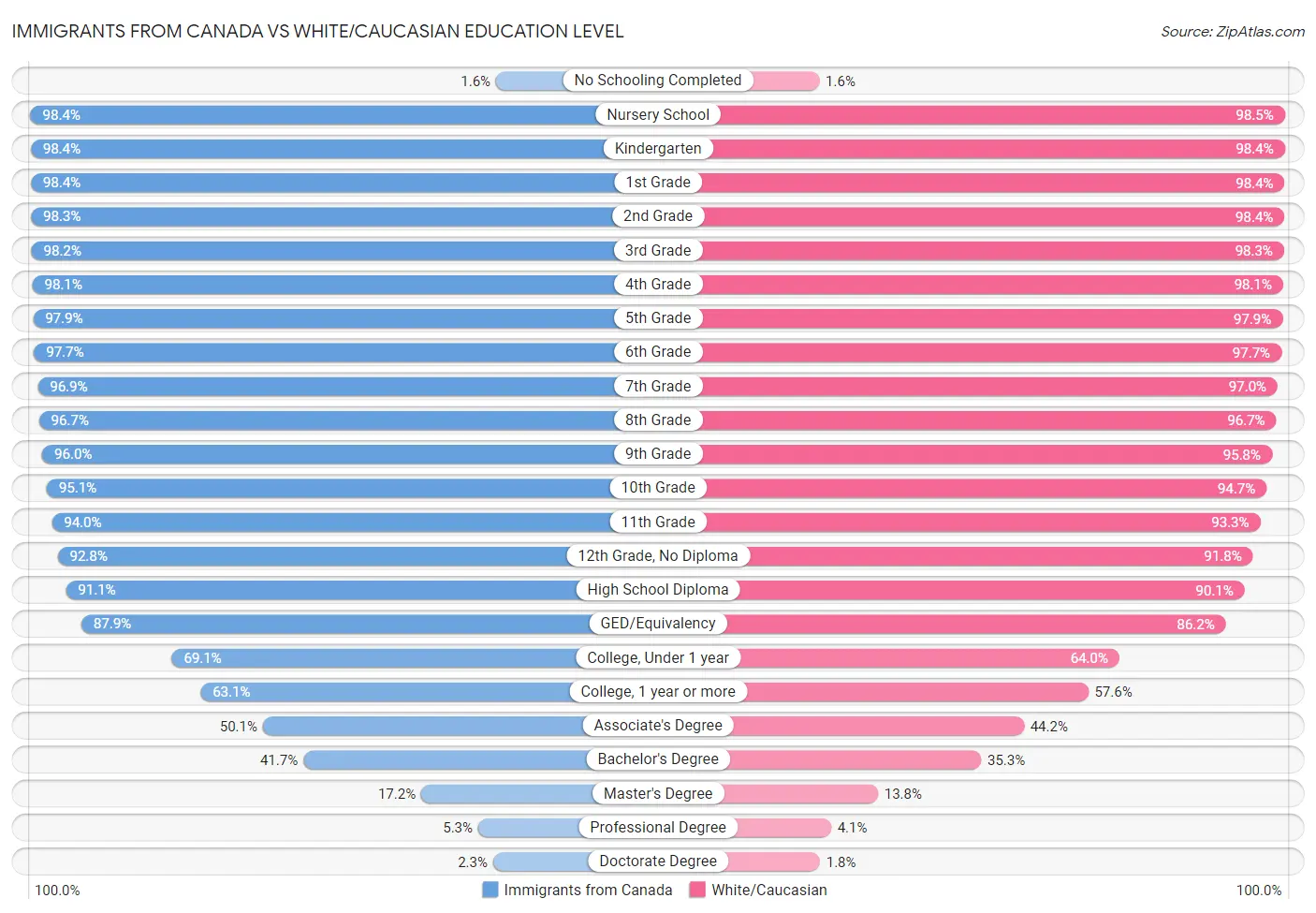
| Education Level Metric | Immigrants from Canada | White/Caucasian |
| No Schooling Completed | Exceptional 1.6% | Exceptional 1.6% |
| Nursery School | Exceptional 98.4% | Exceptional 98.5% |
| Kindergarten | Exceptional 98.4% | Exceptional 98.4% |
| 1st Grade | Exceptional 98.4% | Exceptional 98.4% |
| 2nd Grade | Exceptional 98.3% | Exceptional 98.4% |
| 3rd Grade | Exceptional 98.2% | Exceptional 98.3% |
| 4th Grade | Exceptional 98.1% | Exceptional 98.1% |
| 5th Grade | Exceptional 97.9% | Exceptional 97.9% |
| 6th Grade | Exceptional 97.7% | Exceptional 97.7% |
| 7th Grade | Exceptional 96.9% | Exceptional 97.0% |
| 8th Grade | Exceptional 96.7% | Exceptional 96.7% |
| 9th Grade | Exceptional 96.0% | Exceptional 95.8% |
| 10th Grade | Exceptional 95.1% | Exceptional 94.7% |
| 11th Grade | Exceptional 94.0% | Exceptional 93.3% |
| 12th Grade, No Diploma | Exceptional 92.8% | Exceptional 91.8% |
| High School Diploma | Exceptional 91.1% | Exceptional 90.1% |
| GED/Equivalency | Exceptional 87.9% | Good 86.2% |
| College, Under 1 year | Exceptional 69.1% | Poor 64.0% |
| College, 1 year or more | Exceptional 63.1% | Tragic 57.6% |
| Associate's Degree | Exceptional 50.1% | Tragic 44.2% |
| Bachelor's Degree | Exceptional 41.7% | Tragic 35.3% |
| Master's Degree | Exceptional 17.2% | Tragic 13.8% |
| Professional Degree | Exceptional 5.3% | Poor 4.1% |
| Doctorate Degree | Exceptional 2.3% | Fair 1.8% |
Immigrants from Canada vs White/Caucasian Disability
When considering disability, the most significant differences between Immigrants from Canada and White/Caucasian communities in the United States are seen in disability age under 5 (1.4% compared to 1.7%, a difference of 15.0%), disability age 35 to 64 (11.0% compared to 12.6%, a difference of 14.7%), and disability age 65 to 74 (22.1% compared to 24.2%, a difference of 9.9%). Conversely, both communities are more comparable in terms of cognitive disability (16.5% compared to 17.0%, a difference of 3.0%), disability age over 75 (45.7% compared to 47.3%, a difference of 3.6%), and hearing disability (3.5% compared to 3.7%, a difference of 6.3%).
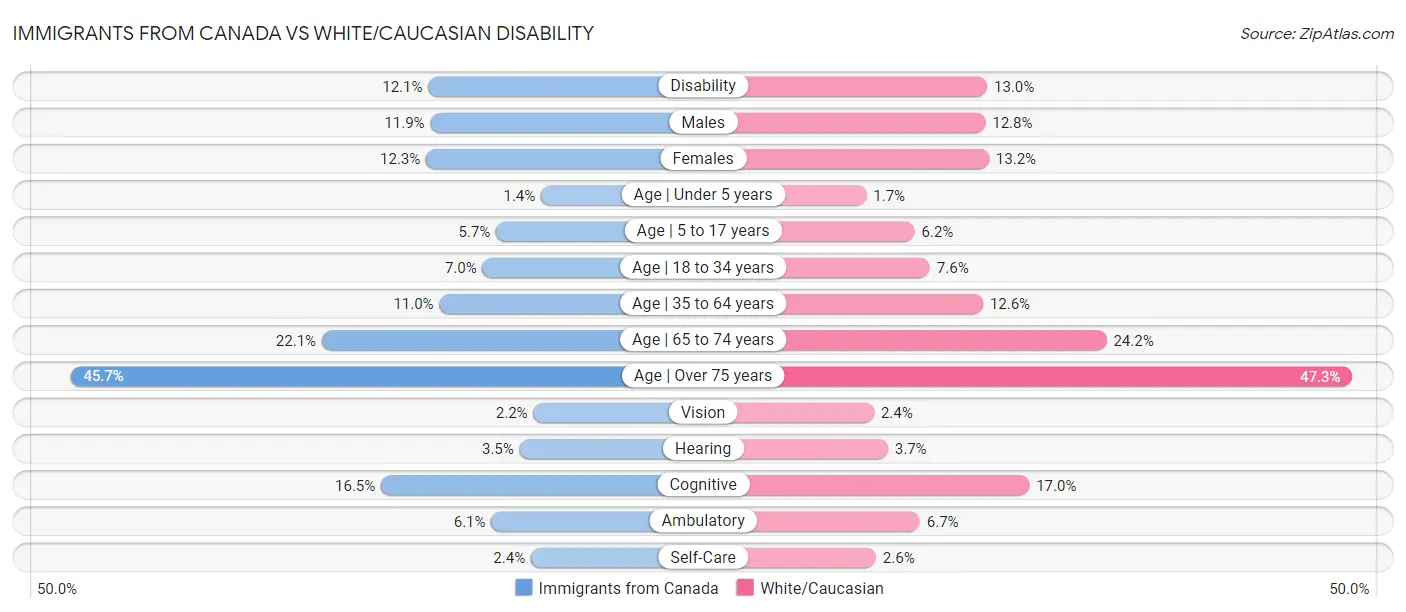
| Disability Metric | Immigrants from Canada | White/Caucasian |
| Disability | Tragic 12.1% | Tragic 13.0% |
| Males | Tragic 11.9% | Tragic 12.8% |
| Females | Fair 12.3% | Tragic 13.2% |
| Age | Under 5 years | Tragic 1.4% | Tragic 1.7% |
| Age | 5 to 17 years | Fair 5.7% | Tragic 6.2% |
| Age | 18 to 34 years | Tragic 7.0% | Tragic 7.6% |
| Age | 35 to 64 years | Good 11.0% | Tragic 12.6% |
| Age | 65 to 74 years | Exceptional 22.1% | Tragic 24.2% |
| Age | Over 75 years | Exceptional 45.7% | Average 47.3% |
| Vision | Average 2.2% | Tragic 2.4% |
| Hearing | Tragic 3.5% | Tragic 3.7% |
| Cognitive | Exceptional 16.5% | Exceptional 17.0% |
| Ambulatory | Average 6.1% | Tragic 6.7% |
| Self-Care | Exceptional 2.4% | Tragic 2.6% |